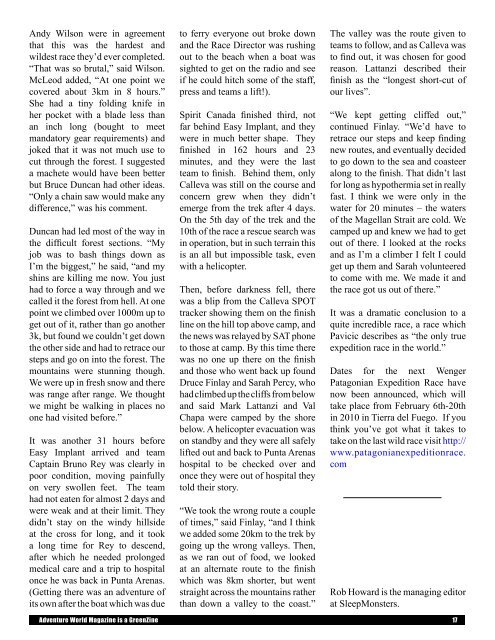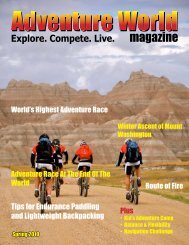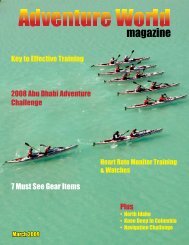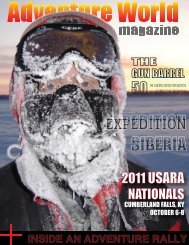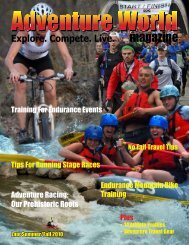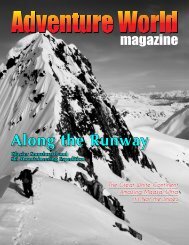view issue - Adventure World Magazine
view issue - Adventure World Magazine
view issue - Adventure World Magazine
Create successful ePaper yourself
Turn your PDF publications into a flip-book with our unique Google optimized e-Paper software.
Andy Wilson were in agreement<br />
that this was the hardest and<br />
wildest race they’d ever completed.<br />
“That was so brutal,” said Wilson.<br />
McLeod added, “At one point we<br />
covered about 3km in 8 hours.”<br />
She had a tiny folding knife in<br />
her pocket with a blade less than<br />
an inch long (bought to meet<br />
mandatory gear requirements) and<br />
joked that it was not much use to<br />
cut through the forest. I suggested<br />
a machete would have been better<br />
but Bruce Duncan had other ideas.<br />
“Only a chain saw would make any<br />
difference,” was his comment.<br />
Duncan had led most of the way in<br />
the difficult forest sections. “My<br />
job was to bash things down as<br />
I’m the biggest,” he said, “and my<br />
shins are killing me now. You just<br />
had to force a way through and we<br />
called it the forest from hell. At one<br />
point we climbed over 1000m up to<br />
get out of it, rather than go another<br />
3k, but found we couldn’t get down<br />
the other side and had to retrace our<br />
steps and go on into the forest. The<br />
mountains were stunning though.<br />
We were up in fresh snow and there<br />
was range after range. We thought<br />
we might be walking in places no<br />
one had visited before.”<br />
It was another 31 hours before<br />
Easy Implant arrived and team<br />
Captain Bruno Rey was clearly in<br />
poor condition, moving painfully<br />
on very swollen feet. The team<br />
had not eaten for almost 2 days and<br />
were weak and at their limit. They<br />
didn’t stay on the windy hillside<br />
at the cross for long, and it took<br />
a long time for Rey to descend,<br />
after which he needed prolonged<br />
medical care and a trip to hospital<br />
once he was back in Punta Arenas.<br />
(Getting there was an adventure of<br />
its own after the boat which was due<br />
to ferry everyone out broke down<br />
and the Race Director was rushing<br />
out to the beach when a boat was<br />
sighted to get on the radio and see<br />
if he could hitch some of the staff,<br />
press and teams a lift!).<br />
Spirit Canada finished third, not<br />
far behind Easy Implant, and they<br />
were in much better shape. They<br />
finished in 162 hours and 23<br />
minutes, and they were the last<br />
team to finish. Behind them, only<br />
Calleva was still on the course and<br />
concern grew when they didn’t<br />
emerge from the trek after 4 days.<br />
On the 5th day of the trek and the<br />
10th of the race a rescue search was<br />
in operation, but in such terrain this<br />
is an all but impossible task, even<br />
with a helicopter.<br />
Then, before darkness fell, there<br />
was a blip from the Calleva SPOT<br />
tracker showing them on the finish<br />
line on the hill top above camp, and<br />
the news was relayed by SAT phone<br />
to those at camp. By this time there<br />
was no one up there on the finish<br />
and those who went back up found<br />
Druce Finlay and Sarah Percy, who<br />
had climbed up the cliffs from below<br />
and said Mark Lattanzi and Val<br />
Chapa were camped by the shore<br />
below. A helicopter evacuation was<br />
on standby and they were all safely<br />
lifted out and back to Punta Arenas<br />
hospital to be checked over and<br />
once they were out of hospital they<br />
told their story.<br />
“We took the wrong route a couple<br />
of times,” said Finlay, “and I think<br />
we added some 20km to the trek by<br />
going up the wrong valleys. Then,<br />
as we ran out of food, we looked<br />
at an alternate route to the finish<br />
which was 8km shorter, but went<br />
straight across the mountains rather<br />
than down a valley to the coast.”<br />
The valley was the route given to<br />
teams to follow, and as Calleva was<br />
to find out, it was chosen for good<br />
reason. Lattanzi described their<br />
finish as the “longest short-cut of<br />
our lives”.<br />
“We kept getting cliffed out,”<br />
continued Finlay. “We’d have to<br />
retrace our steps and keep finding<br />
new routes, and eventually decided<br />
to go down to the sea and coasteer<br />
along to the finish. That didn’t last<br />
for long as hypothermia set in really<br />
fast. I think we were only in the<br />
water for 20 minutes – the waters<br />
of the Magellan Strait are cold. We<br />
camped up and knew we had to get<br />
out of there. I looked at the rocks<br />
and as I’m a climber I felt I could<br />
get up them and Sarah volunteered<br />
to come with me. We made it and<br />
the race got us out of there.”<br />
It was a dramatic conclusion to a<br />
quite incredible race, a race which<br />
Pavicic describes as “the only true<br />
expedition race in the world.”<br />
Dates for the next Wenger<br />
Patagonian Expedition Race have<br />
now been announced, which will<br />
take place from February 6th-20th<br />
in 2010 in Tierra del Fuego. If you<br />
think you’ve got what it takes to<br />
take on the last wild race visit http://<br />
www.patagonianexpeditionrace.<br />
com<br />
Rob Howard is the managing editor<br />
at SleepMonsters.<br />
<strong>Adventure</strong> <strong>World</strong> <strong>Magazine</strong> is a GreenZine 17


